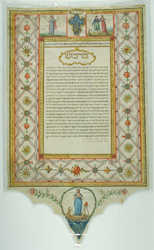
Ketubah
On vellum. Rome, 1817
| Bridegroom: Hananiah ben Reuben Mansi |
| Bride: Grazia bat Jacob Hayyim Azkariel |
Micrography surrounding the text includes biblical passages and prayers relating to marriage. The ornamented cartouches above and below the text include both scenes and playful ditties relating to love and courtship.
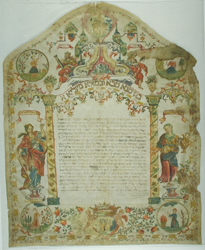
Ketubah
On vellum. Ferrara, 1736
| Bridegroom: Eliezer Aaron ben David Abraham ha-Kohen |
| Bride: Guidita bat David ben Moses ha-Kohen |
The sign of the outspread hands on the top and the bottom indicate that both the bride and the groom are of priestly families. The name of each of their families thus ends with Kohen. The two figures on top represent wisdom (right) and courage (left). The four cartouches along the inner border depict the four seasons. The writing along the border is from the Book of Ruth. The two large figures on either side of the document represent plenty (right) and justice (left). The pomagranates on the bottom and in the cartouche, depicting summer, symbolize fertility.
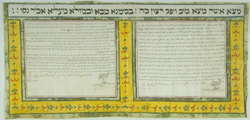
Ketubah
On vellum. Livorno, 1806
| Bridegroom: Raphael Joseph ben David Hayyim Franco |
| Bride: Hannah bat Jacob Pereira de Leon |
This ketubah is quite different in appearance from the others in this exhibit. The bride and groom are descendents of Sephardic (Spanish) Jews who settled in Italy, rather than of native Italian Jewish families as are the other couples mentioned in the ketubot on display. The Sephardic community had a somewhat different rite and a different tradition of document ornamentation. This ketubah is much less ornate and detailed and the calligraphy is in cursive rather than the large block letters of the traditional Italian Ketubot.
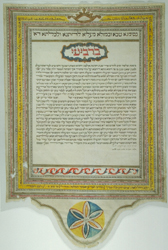
Ketubah
Rome, 1797
| Bridegroom: Nathan ben Solomon Rignani |
| Bride: Stella bat Menahem Modigliani |
The geometric ornamental borders on this ketubah differ from the more traditional floral designs found on most Italian ketubot of this period. The Hebrew writing along the border is from the Book of Ruth followed by a series of blessings evoking the patriarchs and matriarchs, and Mordecai and Esther (surprisingly, since the two were not husband and wife). The micrography on the lower rounded edge is of the seven blessings recited at the Jewish wedding ceremony.
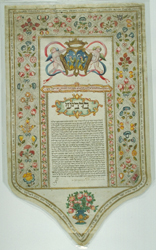
Ketubah
On vellum. Rome, 1793
| Bridegroom: Abraham Hayyim ben Ephraim Modigliani |
| Bride: Rosa bat Menahem Modigliani |
Micrography surrounding the text consists of the entire Book of Ruth. The coat of arms above the text is apparently that of the Modigliani family (ancestors of the famous painter?).
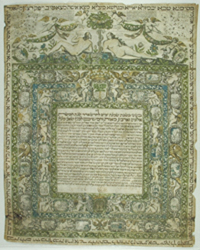
Ketubah
On vellum. Nice, 1690
| Bridegroom: Jacob ben Samson Vallabrega |
| Bride: Rosa bat Joseph Kohen |
The scene above the text depicts Adam and Eve in the Garden of Eden, echoing one of the seven blessings recited at the Jewish wedding ceremony. The border surrounding the text includes miniature biblical scenes, many of which relate to marriage.
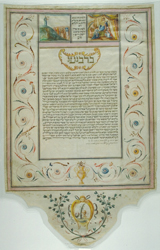
Ketubah
On vellum. Rome, 1820
| Bridegroom: Moses ben Reuben Mansi |
| Bride: Esther bat Mordecai Samuel Modigliani |
The two illustrations on the top allude to the names of the bride and groom: Moses and Esther. The ornamental border interweaves flowers and micrography. The rounded lower edge is a typical feature of the ketubot of the Jews of Rome. The micrography outlining the urn at the bottom of the border consists of the seven blessings recited during the marriage ceremony. The micrography woven into the ornamental border is made up of verses from the Book of Psalms and other passages relating to marriage.